#duke of bretagne
Text
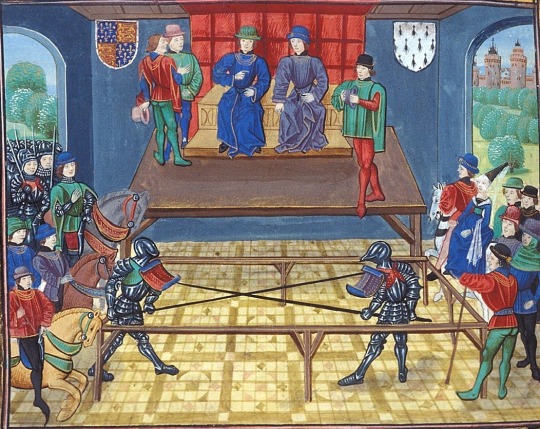
Jousting in Vannes, Brittany. The Earl of Buckingham (Thomas of Woodstock) and the Duke of Bretagne (John IV/V "The Conqueror")
Chroniques de Jean Froissart
#jousting#joust#knights#vannes#brittany#france#europe#european#history#medieval#england#knight#art#jean froissart#earl of buckingham#duke of bretagne#john the conqueror#thomas of woodstock#john iv#john v#combat#duel#chivalry#chivalric#coat of arms#heraldry
20 notes
·
View notes
Text
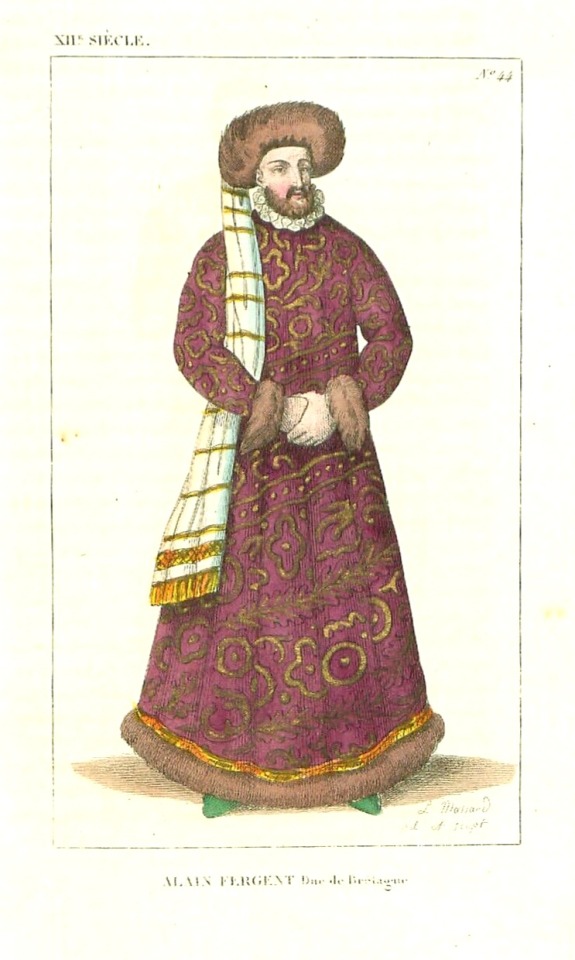
Alain Fergent, Duc de Bretagne.
Alain IV of Brittany (1060-1119), son of Hoël II of Brittany and Havoise of Brittany, was Count of Cornouaille, Rennes and Nantes and finally Duke of Brittany from 1084 to 1115.
#royaume de france#duché de bretagne#alain fergent#duc de bretagne#full length portrait#maison de cornouaille#duchy of brittany#duke of brittany#alain iv of brittany#full-length portrait#bretagne
4 notes
·
View notes
Text
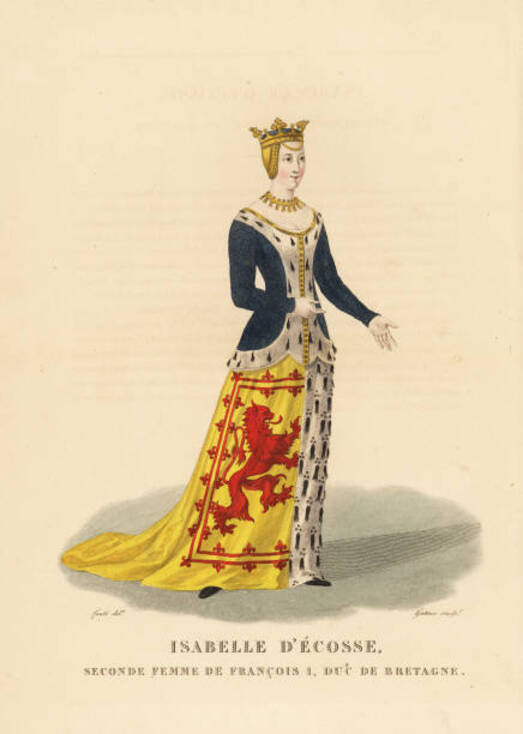
Isabella Stewart,(Isabelle d'Escosse) Isabel of Scotland.
I love this pic of our Scottish Princess who spent most of her life in France Her outfit is descride as (an) armorial robe with coat of arms of Scotland (red lion rampant with double tressure) and Brittany (ermine). She wears a crown, gold necklace, and ermine trimmed surtout. and is a Handcoloured copperplate engraving by Georges Jacques Gatine after an illustration by Louis Marie Lante from Galerie Francaise de Femmes Celebres, Paris, 1827
Isabella was born between 1425 and 1427, the daughter of James I, King of Scots, and Joan Beaufort. It was said she was more beautiful than her elder sister Margaret, and Jean VI, duc de Bretagne, proposed to marry her to his son François I; thus he sent ambassadors to Scotland to take a description of her. They reported that she was handsome, upright and graceful, but that she also seemed simple. The Duke's reply was: 'My friends, return to Scotland and bring her here, she is all I desire, and I will have no other; your clever women do more harm than good'.
Isabella became the second wife of François I, duc de Bretagne, at the Château d'Auray on 30 October 1442, after which the whole court went to Rennes for eight days of festivities. She and François had two daughters, Marguerite and Marie, who would both have progeny.
Upon the death of her sister Margaret, married to the future King Louis XI, Isabella penned an illuminated prayer book of hours, which is preserved to this day.
Upon her husband's death in 1450, there was talk of marriage between Isabella and the prince of Navarre, but this fell through due to the disapproval of Charles VII of France. Isabella died in
Isabella was born between 1425 and 1427, the daughter of James I, king of Scots, and Joan Beaufort. It was said she was more beautiful than her elder sister Margaret, and Jean VI, duc de Bretagne, proposed to marry her to his son François I; thus he sent ambassadors to Scotland to take a description of her. They reported that she was handsome, upright and graceful, but that she also seemed simple. The Duke's reply was: 'My friends, return to Scotland and bring her here, she is all I desire, and I will have no other; your clever women do more harm than good'.
Isabella became the second wife of François I, duc de Bretagne, at the Château d'Auray on 30 October 1442, after which the whole court went to Rennes for eight days of festivities. She and François had two daughters, Marguerite and Marie, who would both have progeny.
Upon the death of her sister Margaret, married to the future King Louis XI, Isabella penned an illuminated prayer book of hours, _Livre d'Isabeau d'Escosse,_ which is preserved to this day.
Upon her husband's death in 1450, there was talk of marriage between Isabella and the prince of Navarre, but this fell through due to the disapproval of Charles VII of France. Isabella died in 1494.
11 notes
·
View notes
Text

In England, English and Norman barons kill each other to seize the throne and in France, the Carolingian unity having been shattered, the little Capetian king managed his meager possessions under the vigilant and hostile eye of the great feudal lords who watched over over their strongholds and control his every move. Brittany, if it wished, could finally spread its wings. Conan III is careful not to do this and is content to govern peacefully, only too happy that the English and French ropes which hold him by the neck are suddenly so weak. A good duke, good husband, good Breton, he has everything going his way, but was unfortunately a bad father; on his deathbed he disowns Hoël, his son, and chooses as his heir Conan IV, a little boy of 9 years old, the son of his daughter Bertha.
Gilles Martin-Chauffier, Le Roman de la Bretagne
#twelfth century#hoël de cornouaille#bertha de cornouaille#ft konan iii's hand and constance of mayenne i guess 😂#so. I bought the bande dessinée ''Breizh'' bc I'm unfortunately Very Easy and they used this bit from Martin-Chauffier#I agree with historians like Keats-Rohan et al that believe Hoël was somewhat In On It and his spats with Bertha and her husband were#almost always more small-scale (eg how independent Nantes should be relative to the ducal crown etc etc)#but I do sometimes wonder and the BD bit got it rotating again...#given Hoël was iirc the eldest of Konan III's kids and also a dude man in the early 1100's if he was ever tempted by the Cain Instinct...#there's something about Bertha and Hoël largely being allies but also siblings who quarrel on the political stage...#(also an example of the kind of nationalistic writing flourishes I have to wade through every day I'm fighting for my life out here 😭)#(also the idyllic verbiage when Bertha was living in England during said war where the English were killing each other. like...)#shakespeareomnibus
14 notes
·
View notes
Photo

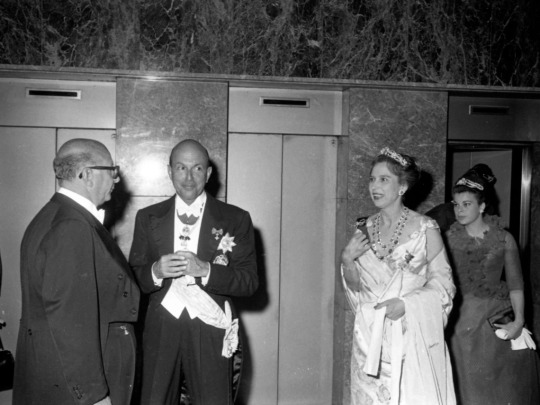


Guests, including Princess Maria Gabriella of Savoy, the Prince of Naples, King Umberto II and Queen Marie José of Italy, Infanta María Cristina and Infanta Beatriz of Spain, the Duke and Duchess of Calabria and Prince Rainier III and Princess Grace of Monaco, depart the Hotel Grande Bretagne to attend the first ball at the Royal Palace of Athens, during the celebrations of the wedding of the Prince of Asturias and Princess Sophia of Greece, 1962.
23 notes
·
View notes
Text
Anne de Beaujeu
Anne de Beaujeu (Anne de France, 1461-1522)
Unofficial regent of France and duchess of Bourbon

Anne de Beaujeu provides an example of female political authority in a country where the Salic Law prevented women from assuming the crown. She also illustrates the tension between an increasingly centralized monarchy on the one hand and feudal independence on the other, having supported both causes at different times in her life. Probably born in 1461, Anne de Beaujeu was the oldest of the surviving children of Louis XI, king of France, and the one said to resemble him most intellectually and temperamentally. When this king died in 1483 leaving a thirteen-year-old Charles VIII on the throne, Anne and her husband, Pierre de Beaujeu, as his guardians, assumed control. In so doing, they resisted Louis d'Orléans, the next in line to the throne, who wished to be named regent. Louis and his supporters sought help from the estates-general who met in 1484 but who ultimately supported Anne's cause. Referred to as Madame la Grande (Grand Madam), Anne was recognized by the court and by foreign emissaries as the person actually ruling France during the early years of Charles's reign.
In 1488 she and Charles VIII squelched a noble uprising, the Guerre Folle (the Foolish War) led by Louis d'Orléans and Francis II duke of Brittany. Charles then married the new duchess of Brittany, Anne, to ensure the duchy's loyalty to France. Meanwhile Pierre de Beaujeu's two older brothers had died, leaving Pierre with the Bourbon inheritance. Anne and her husband were now the richest and most powerful nobles in France. In 1491, after the loss of one infant and fifteen years of childlessness, Anne gave birth to a daughter, Suzanne. As Charles VIII grew increasingly independent of his older sister, Anne redirected her attention to her own lands and feudal duties, though she remained his advisor while retaining her ties to the court. When Charles died suddenly in 1498 leaving no heirs, Louis d'Orléans became king of France. Neither his previous attacks on the crown nor his well-known personal vices inspired confidence in his subjects, so the support of Anne de Beaujeu and her husband were instrumental in a smooth accession to the throne. Anne agreed to overlook their antagonistic past and did not hinder the annulment Louis immediately requested from her physically disabled sister, Jeanne. In exchange, Louis XII waived the royal rights to the Bourbon inheritance in the case that Anne and Pierre did not have a male heir. Once all this had been established, the Bourbon's relationship with Louis XII and his new queen, Charles's widow Anne de Bretagne, became quite cordial. Anne de Beaujeu no longer held any direct influence, however, over the governance of the French state.
In 1504 or 1505, after the death of her husband and before she arranged a marriage for her daughter, Anne wrote Suzanne a book of lessons, Les Enseignements d'Anne de France, duchesse de Bourbonnois et d'Auvergne, à sa fille Susanne de Bourbon, modeled on the book that Louis IX had written for his daughter, the one her own father had written for Charles, and the writings of Christine de Pizan. Anne's version contains conventional advice on the appropriate behavior for noblewomen. During her unofficial regency, Anne had overseen the education of many young noblewomen at court, including Louise de Savoie, Marguerite d'Autriche, and Diane de Poitiers. The humble feminine figure that emerges from the Enseignements, however, seems at odds with their independent author. More easily recognizable are the anxieties about life as an older widow distant from court. The Enseignements ends with a tale about a noblewoman who bravely sacrifices her only child for the honor of her family and the interests of the king. Suzanne was, in fact, married shortly thereafter to a cousin to protect the integrity of the Bourbon inheritance.
In contrast to the moral of her tale, however, the interests of a noble family and those of the crown did not always overlap. Before she died, Anne witnessed the opposition of two adults whom she had raised from childhood: her son-in-law, the connétable de Bourbon, and Louise de Savoie, mother of Francis I, successor to Louis XII. Louise and her son, suspicious of the wealth and power of the connétable, the Bourbon heir, challenged his inheritance. After losing the domain that Anne had so carefully built up and defended during her lifetime, the connétable, perhaps with Anne's bitter approval, responded by betraying the French king Francis I- the other cause that Anne had defended so staunchly during her brother's reign. Anne died in 1522, before this ultimate betrayal.
Emily Thompson in Encyclopedia of Women in the Renaissance.
#xv#xvi#anne de france#anne de beaujeu#regents#duchesse de bourbon#louis xi#charles viii#pierre de beaujeu#louis xii#françois ii de bretagne#anne de bretagne#la guerre folle#suzanne de bourbon#sainte jeanne de france#louise de savoie#marguerite d'autriche#diane de poitiers#charles iii de bourbon#le connétable de bourbon#françois i#proof that anne approved of this ? i didn't find anything#the connétable's betrayal is a complex story#one can point fingers at françois i and louise de savoie too#emily thompson#encyclopedia of women in the renaissance
17 notes
·
View notes
Text
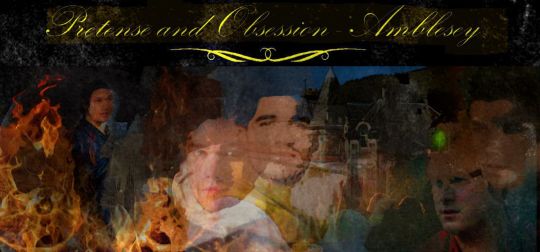
Pretense and Obsession - Amblesey
Chapter 34 of 34
Read it on the AO3
Relationship: Blaine Anderson/Kurt Hummel
Characters: Kurt Hummel. Blaine Anderson (Bleyn Deyvenevich Anderov Romanov), Burt Hummel, Rachel Berry, Pamila Anderson (Blaine’s Mother – Pamila Sofia Anderova), Carole Hudson, Finn Hudson, Sebastian Smythe (Sebast'ya Ivanovich), Kitty Wilde (Katrina Sebast’yova), Sam Evans (Samov Evanich), Artie Abrams (Arthur Abrams), Brittany Pierce (Bretagne Peerström), Santana Lopez (Luciana Santana Del los Reyes), Jessie Saint James, Marley Rose, William Schuester, David Karofsky (Deyvid Deyvenovich Karofsky and Mikhkail Deyvenovich Karofsky - identical twins), Tina Cohen-Chang, Noah Puckerman (Neo Pucillo), Michael Chang (Zhang Mei-shan)
Additional Tags: Historical AU, Klaine AU, Regency Period, Witchcraft, Mysticism, Paganism
Summary:
Captain Kurt Hummel rode into battle with his former commander, the Duke of Wellington, at Waterloo, vanquishing the Pork of Paris. Europe is at peace. Raised in status by the unfortunate death of the grandfather of his twins, Count Charmouth replaced the red uniform of military service for the stately attire of the son of a noble landowner. Forced to face the burden of overseeing two estates while raising young children on his own, life is full but not complete. The tedious cycle feels never-ending until someone unexpected graces his door.
3 notes
·
View notes
Text
From Jean-Claude Carrière
Paris, [25 May 1967]
Dear Luis,
Last night was the premier so off we went, Auguste and I, our hearts pounding. I want to give you as accurate a report as possible. I’ll say at once that it was a great success, although I imagine you are indifferent to that.
1) The cuts. Unfortunately there were some. First, the bloodstain. We see Pallas put the towel away and turn to go back to the bed. The bloodstain is ‘perceptible’. This creates slightly odd continuity, very ‘new wave’, between Pallas on the stairs watching the Mongol leave and Pallas in the bedroom putting the towel away.
Major cuts have been made to the castle scene though: the Grünewald painting, the mass (a shame for me) and, inexplicably, the short scene where the butler puts Séverine in the coffin and tells her what to do (‘close your eyes’, etc.). That’s all. It doesn’t change the ‘meaning’ of the story, and in terms of continuity it actually works very well. They’ve cut the fireplace scene, the scene where the butler dresses Séverine, and the walking down the corridor sequence. The point where the Duke comes in with his camera and everything that follows.
Those are the only cuts. And to be honest, I feel quite relaxed about them. As I hadn’t heard from the Hakims in months, I was afraid there would be far more.
2) Public reception. Fantastic. Watching it with a few hundred people, it doesn’t feel like the same film. For example, there was a lot of laughter. The scene with the professor, carried along by a laughing audience, is extraordinary. Then suddenly, they stop laughing and their stomachs drop when he falls down on all fours and says: ‘I love you.’ Another scene they laughed at lot at was the second bit of the sequence with Piccoli and Séverine, when he finds her in the brothel. They didn’t stop laughing from ‘what I liked about you was your virtue…’ up to the chocolates for Pierre. And at the end, when we see Séverine from behind in the arm- chair, some people spoke out aloud, calling Husson an absolute bastard. Which just goes to show how well the audience responds to Séverine and takes her side.
On the way out, I heard someone saying: ‘I couldn’t take my eyes off the screen, I don’t know why.’
There were other laughs, too, when Clémenti shudders with horror at Severine’s birthmark. A shocked ‘Oh!’ when Clémenti arrives at Séverine’s apartment at the end. Different reactions at every turn. You get the sense that, at a certain point, the viewers take off with no clear idea where they are any longer, watching it like a dream.
Auguste told me: ‘The woman next to me was floating ten centimetres above her seat. She was flying without even noticing.’
Everyone was there last night. First, all the actors. On the first row of the balcony, between Sorel and Clémenti, there was a seat left empty, completely by chance, throughout the entire film. But I knew you were sitting there the whole time, incognito.
The Hakims were there too, radiant. The film really has had a staggering opening: the three rooms were full the first day for the first session. It’s been sold in the US for $500,000 to that American distributor who made a fortune with Un Homme et une femme; for $80,000 in Japan, etc. Everyone says it’s making a fortune.
It’s been selected for Venice. Don’t worry about the producers. There’s no point.
Jean Sorel’s wife watched the film surreptitiously at the first session in the afternoon at the Bretagne. Then she came back to watch it again in the evening. Juliette Gréco was ‘fascinated’. Some women were weeping by the end. The quality of the copy was very good. The duel scene, relatively dark, is magnificent.
3) My reaction, of little importance. Once again, I came away feeling utterly battered. It has a powerful effect on me. This time I felt I saw a perfectly real, realist, nucleus: the brothel. And around that nucleus, ‘progressively unreal’ circles. There’s no clear divide between fantasy and reality, just a series of degrees, shades. The characters of Sorel and Clémenti (who never takes part in the fantasy sequences) have a certain unreal quality. They’re intermediaries of a sort. The sequence with the Duke is not definitely imaginary either. It could have happened. What’s wonderful is that it’s not clear.
It made me think a lot of Breton’s famous comment in the Second Manifesto: ‘Everything leads us to believe that there is a point at which life and death, the real and the imaginary… are no longer perceived as contradictions.’ I think that, by circling around that point in the final sequence, you’ve managed to reveal it.
The reviews aren’t out yet, but that doesn’t matter at all. We already know it’ll get good press and it won’t teach you anything new. Better it was bad and instructive.
After the screening, people couldn’t bring themselves to leave. They stayed over an hour discussing the film and most were dazed. Auguste and I came home together. We drank a bottle of Beaujolais, then more alcohol with cheese, and raised our brimming glasses to you. We were happy, very much in love, and a bit drunk.
It was very late when we eventually went to bed. I asked Auguste to put on black stockings, a pink corset and a lace bra, but she doesn’t have any. So, I just said: ‘lie down’. I would like us to conceive a child tonight.
I didn’t miss you, because I know you don’t like those kinds of events. But I reminded myself I really should catch a plane to Mexico every now and again, just to give you a hug.
(Incidentally, Belle de jour is being shown with a very good documentary about Hector Guimard, the famous ‘style nouille’ architect and interior designer. It goes very well with the film.)
Luis, everyone over here says you’ve never been on better form, a lot of them think Belle de jour is your best work (others hate it, which is also important).
Someone said that in ten years’ time, you would make the film to end all films.
Luis, even when you can’t hear anything, when you can’t see anything, when you can’t drive any more, and when the doctors put you on milk and mineral water, YOU HAVE TO MAKE FILMS!
Make them in Patagonian, in Javanese or in Mongolian; make them in Honolulu or in Stalingrad; make them with Lollobrigida, Cardinal Spellman and Johnson’s daughter, hire Steinbeck to write the dialogues, sign up anyone and everyone, put a camera in front of a blank white wall and film that wall for two hours, do whatever, but do something! MAKE FILMS!
Make ten, twenty, films non-stop, it doesn’t really matter whether you want to or not, even when you’re trapped in a wheelchair, you have to make films. Even when you’re dead, you’ll have to carry on making them.
Although I’m beginning to think you’ll never die. Unless you decide to of course.
And finally, in all this news we are accustomed to think of as good news (there’s always a silver lining after all), I have to tell you, so we don’t lose the benefit of feeling cursed, that La Cascade restaurant was completely destroyed in a fire a few days ago.
That’s all,
Sending my best wishes,
Jean-Claude
[PS] Le Figaro has summed up the film as: ‘THE FALL OF A HIGH-CLASS WOMAN’.
Marvellous.
Jo Evans & Breixo Viejo, Luis Buñuel: A Life in Letters
#jo evans#breixo viejo#luis bunuel: a life in letters#luis bunuel#jean claude carriere#andre breton#hector guimard
1 note
·
View note
Text

We finally found the perfect alliance-marriage match for Duke Konan's half-brother Jafrez - AEthelhild Eadricdohtor Aelfricson who is the daughter of Earl Eadric 'the Wild' of Shropshire with 926 men. We arrange a matrilineal marriage as Jafrez is a bastard and will found his own dynasty when he has children in a patrilineal marriage. We want to keep Jafrez as a member of the de Rennes house and Prydain dynasty.
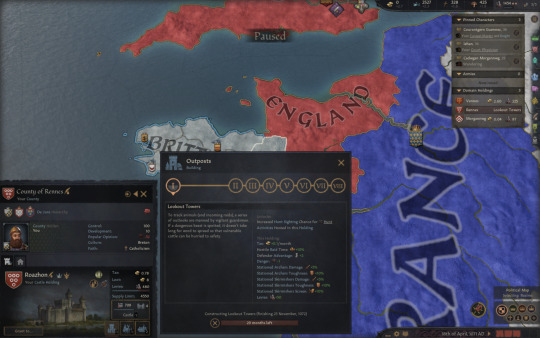
In the County of Rennes, in our castle holding Roazhon, we invest all 95 gold into building Outposts - Lookout Towers which increases Hunt Sighting Chance for Hunt Activities hosted in this holding, not to mention increases the stationed Skirmisher Damage, Toughness and Screen stats.
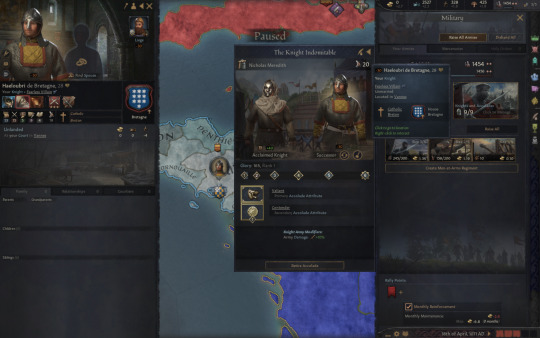
We switch our Successor for the Knight Indomitable Accolade to be the younger Haeloubri de Bretagne who is Brave and also has better prowess of 19.
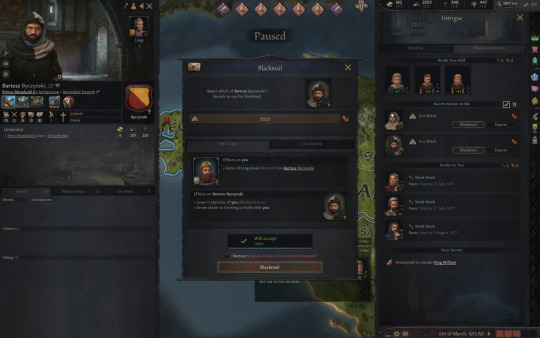
Duke Konan manages to dig up a Witch secret on Prince Maredudd II's Antiquarian Bartosz Byczynski who has an income source, and therefore can be blackmailed for a strong hook that would give a recurrent 10 gold.
0 notes
Photo
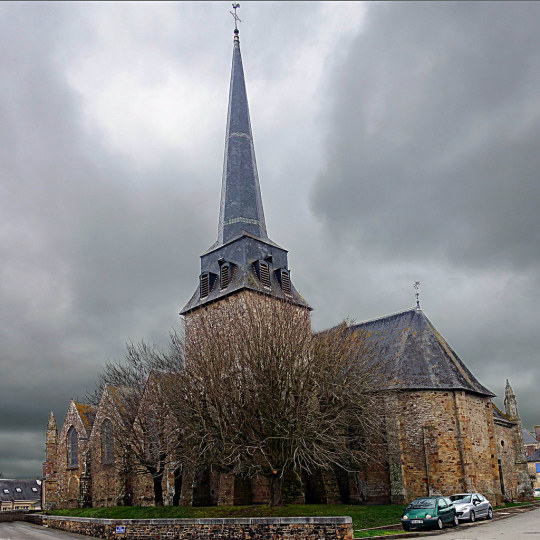
Rannée, Ille-et-Vilaine, France by pom'. Église Saint-Crépin de Rannée La paroisse existe depuis le 10e siècle. À la suite d'un incendie, l’église est reconstruite entre 1168 et 1178 par l’évêque Etienne de Fougères. De cet édifice subsiste la façade occidentale, la base de la tour et le chœur. Le reste est reconstruit aux 16e et 17e siècles, possiblement grâce aux largesses des ducs de Brissac, en Anjou. Inscrite MH en 1974. fr.wikipedia.org/wiki/%C3%89glise_Saint-Cr%C3%A9pin_de_Ra... Church of Saint-Crépin of Rannée The parish has existed since the 10th century. Following a fire, the church was rebuilt between 1168 and 1178 by Bishop Etienne de Fougères. From this building remains the western front, the base of the tower and the choir. The rest was rebuilt in the 16th and 17th centuries, possibly thanks to the generosity of the dukes of Brissac. Listed MH (French National heritage) in 1974. Rannée, Vitré Communauté, Ille-et-Vilaine, Bretagne fr.wikipedia.org/wiki/Rann%C3%A9e March 2023 - Uploaded 2023/03/15 https://flic.kr/p/2ona8wB
0 notes
Text

Jean II d'Alençon (1409-1476), duke of Alençon, count of Perche, son of Jean I and Marie de Bretagne, daughter of duke Jean IV, was a French blood prince and warlord of the 15th century and companion in arms of Joan of Arc.
#maison d'Alençon#royaume de france#full-length portrait#maison de valois#full length portrait#la guerre des cent ans#duc d'alençon
4 notes
·
View notes
Photo
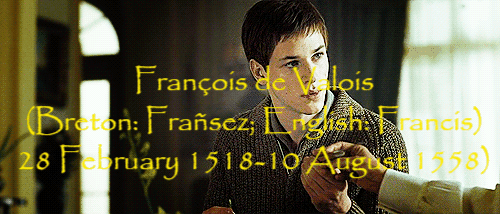
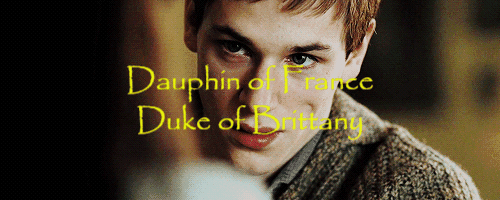
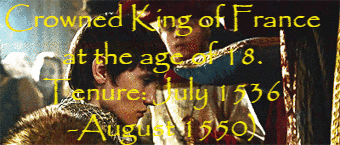

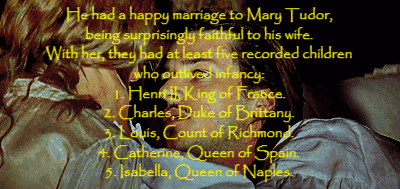

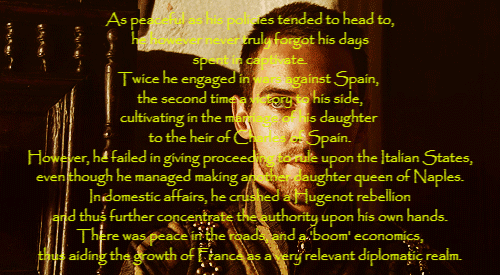
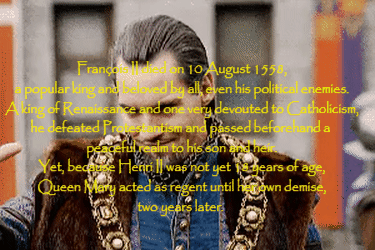
Tʜᴇ AU I·ᴅ ʟɪᴋᴇ ᴛᴏ sᴇᴇ﹐ ᴘᴀʀᴛ VII: Fʀᴀɴᴄ̧ᴏɪs II﹐ Kɪɴɢ ᴏғ Fʀᴀɴᴄᴇ.
[ 𝐺𝑎𝑠𝑝𝑎𝑟𝑑 𝑈𝑙𝑙𝑖𝑒𝑙 𝑎𝑠 𝐷𝑢𝑘𝑒 𝐹𝑟𝑎𝑛𝑐̧𝑜𝑖𝑠/𝑦𝑜𝑢𝑛𝑔 𝐾𝑖𝑛𝑔 𝐹𝑟𝑎𝑛𝑐̧𝑜𝑖𝑠 𝐼𝐼.
𝐽𝑜𝑛𝑎𝑡𝘩𝑎𝑛 𝑅𝘩𝑦𝑠-𝑀𝑒𝑦𝑒𝑟𝑠 𝑎𝑠 𝑜𝑙𝑑𝑒𝑟 𝐾𝑖𝑛𝑔 𝐹𝑟𝑎𝑛𝑐̧𝑜𝑖𝑠 𝐼𝐼 𝑜𝑓 𝐹𝑟𝑎𝑛𝑐𝑒.]
#Alternative History#historical au#François de Valois#Francis of Valois#Francis duke of Brittany#Duc de Bretagne#Francis III#François III#what if#son of#François I#Francis I#King of France#and#Claude of France#Queen Claude#House of Valois-Angouleme#House of Valois#Valois dynasty#Mary Tudor#Queen Mary I#Marie d'Angleterre#Tudor dynasty#House of Tudor#Tudors#The Tudors#Tudor#Gaspard Ulliel#as#Dauphin François
21 notes
·
View notes
Text
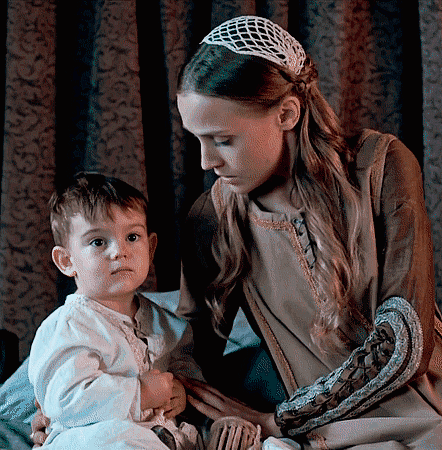
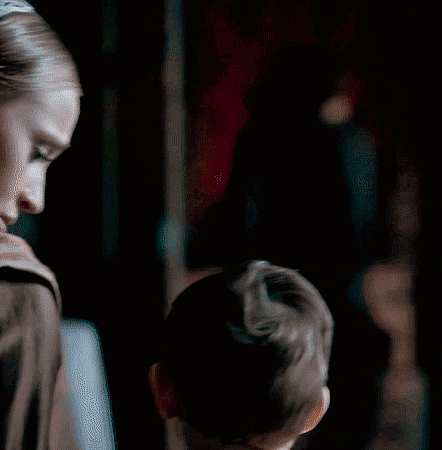
The name that Constance chose for her son predisposes him to his succession. The symbolic figure of King Arthur was reclaimed by Henry II. Amaury Chauou explains that the English King wishes to endow himself with “a conquering past and to legitimize his accession of the throne”. The objective is to compete with the sanctification of the Capetian dynasty through Charlemagne. This new cult of King Arthur is supported by so-called discoveries. Firstly, Arthur's sword, named Excalibur, is found in Glastonbury, converted into a sanctuary of English royalty. The tomb of Arthur was exhumed in 1191. The Arthurian legend experiences, at this period, a real renewal of interest and great success. This instrumentality is reversed by Constance. If Henry II reinvests the Arthurian figure to make it a protective king of his people, then the newborn symbolizes Bretons' hope fighting for their independence, which appears as a challenge in Henry II's eyes. By calling him that, Constance gave a certain power and value to the future title of her son. By selecting this name, she binds her son to kinship and honors. In fact, names identify kinship groups and belong to family patrimonies. But Constance did not name her son Alan, Conan, or even Hoël, common names of the dukes of Brittany in the high middle ages and also belong to a ducal heritage. Arthur’s name gives the future duke a symbolic value that is mythical, giving the Duke’s future title a superior, almost heroic and protective dimension.
-Élodie Chaudet, La duchesse Constance de Bretagne et le gouvernement en héritage à la fin du XIIe siècle
99 notes
·
View notes
Photo

#nantes#france#paysdelaloire#chateau#castle#chateaudesducs#dukes#whitestone#bretagne#igersnantes#nantescity#nantesmaville#history#historyoffrance#travelphotography#igersfrance#instagood#travel#travelgram#nantespassion#architecture#instatravel#traveling#loireatlantique
2 notes
·
View notes
Link
#blogs i love#françois ier#francis i#françois duc de bretagne#francois duke of brittany#henri ii#henri duc d'orleans#charles v#charles quint#louise de savoie#margaret of austria#french history#spanish history#holy roman empire#habsburg-valois wars#habsburg#valois#1526#1530#eleanor of austria#16th century#renaissance#the freelance history writer
2 notes
·
View notes
Photo

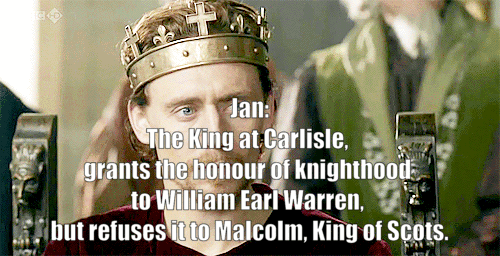




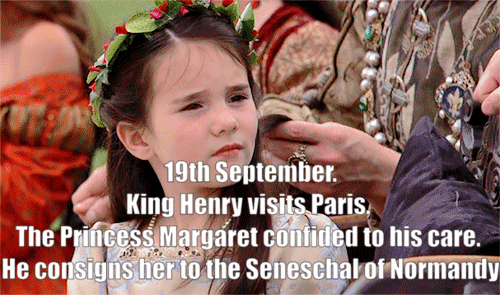
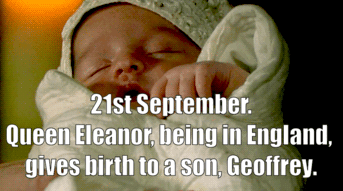

Selected events of Henry II’s reign.
<<A.D. 1158>>
Jan: The King at Carlisle, grants the honour of knighthood to William Earl Warren, but refuses it to Malcolm, King of Scots.[...] The King fortifies the Castle of Were, i.e., Wark in Wark, or Werk. Northumberland.
A Charter, dated at Nottingham, and addressed to Nottingham. Robert, Bishop of Lincoln; whereby the King certifies that he has restored Ricardo de Haia Constabularlam suam de Lincolscira et custodiani castelli mei de Lincoln* et terram qua fiiit joatris ejus. Witnesses, Thorms the Chancellor; Reginald, Earl of Cornwall; William, the King's brother; Richard de Humez, Constable; Robert de Novo-burgo ; R. de Sancto Remigio. A Charter, dated at Nottingham in favour of Furness Abbey, attested by Earl Reginald (of Cornwall) ; Robert, Earl of Leicester; Warin fitz Gerold, Chamberlain ; and Manasser Biset, Dapifer.
Feb-March: During these two months the King probably visited Oxfordshire, Hampshire, and Wiltshire. The Charters which we may refer to this period, are:
One, dated at Woodstock, whereby the King gives "to William Malduit, son of William Malduit, my Chamberlain, the Barcny which was his father's on the day that he became the King's man at Wudestoc, to wit, Hameslape and Maneton, which I gave to his father at Nottingham."
Witnesses, Robert, Bishop of Lincoln; Thomas the Chancellor; Richard de Haia; Robert de Montfort ; William de St. John ; William de Caisneto ; Hugh de Piris; William de Lanval ; and William de Watevill. [...]
April: [...] from Worcester, it is probable that the King passed to Tewkesbury. A Writ, there dated, and attested by Tewkesbury. Gregory (perhaps a clerk of the King), admonishes the tenants of the Abbey of Malmesbury that they perform due services to the Abbey.
This year is distinguished as one in which the King is said to have made a summer progress. [...] there is some probability that between April and August of this year, the King visited London.
—
A Charter, dated at Westminster, is in favour of Bermondsey Priory, and is attested by Theobald, Archbishop of Canterbury ; Thomas the Chancellor; and Manasser Biset, Dapifer.
July 27: Geoffrey, the King’s brother, died at Nantes.
August. Just before his transfretation to Normandy, was engaged in hostilities with Rese, Prince of S. Wales, from whom he (South Wales.) received hostages.
The year 1158 must be assigned to this fact (if such it was), not the year 1157, as the Welsh Chronicle has it. In the same month of August the King crossed the Portsmouth or sea to Normandy. He probably embarked from Portsmouth or Southampton, leaving the Queen at Winchester.
King Henry holds a conference with Louis VII. on the inter Gisors and River Epte. They agree on a marriage between Prince Henry of England and the Princess Margaret of France.
September:
8th. King Henry at Argentan summons the army of Normandy to muster at Avranches at Michaelmas, against Earl Conan who had invaded Nantes.
19th. King Henry visits Paris. The Princess Margaret confided to his care. He consigns her to Robert de Newburg (then Seneschal of Normandy). The King is said to have been now at Mantes.
21st. Queen Eleanor, being in England, gives birth to a son, Geoffrey.
29th. King Henry at Avranches. Earl Conan appears before him, and surrenders Nantes. Henry makes Conan a Duke. The Chancellor (Becket) and Henry de Pomerai appear in the above year, acting exceptionally and in three counties, as judicial functionaries. There was no regular Iter in the English provinces.
October:
9th. Oct. 9. The King goes to Nantes, in Bretagne. He is armed with additional powers against the disaffected Bretons in virtue of his office as Seneschal of France.The King besieges and takes Thouars (Castrum Toarcii). The King goes to Le Mans/ and there meets Louis of France.
November:
23rd: The King accompanies Louis VII visiting the Norman Abbey of St. Michael in periculo maris (Mont St. Michael). Both Kings adjourn to Avranches.K. Henry is next found at Baieux with Louis. Then at Caen. Then at Rouen, still entertaining Louis. Another authority seems to trace a nearly contemporary progress of the King through Normandy as bringing him successively to Pacey. And to Evreux. And to Neufbourg. And to Bee.
29th. The Queen is now at Salisbury. Richard de Luci is acting as a Justiciar in England. We have a precept of "Alianore, Queen of England, Duchess of Aquitaine and Normandy, and Countess of Anjou" in behalf of Matilda, Countess (dowager) of Chester. It is dated at Salisbury, and attested by Joceline de Bailol. Also we have a Certificate whereby " A.,Queen of England, etc.," confirms a quit-claim given in her presence by Robert Flambard to Warner de Lusoriis. Witnesses, Gosceline, Bp of Sarum; Earl Reginald
Sources: “Court, Household and Itinerary of K. Henry II”.
Fancast: Tom Hiddleston as King Henry II of England; Sam Claffin as Earl Conan; David Oakes as Geoffrey of Anjou; Daniel Gillies as Reese, Prince of South Wales. (Gifs are not mine to claim ownership. They are only used here to illustrate the characters and events of history.)
#Henry II of England#Henry II#King Henry II of England#King Henry II#Henry Fitzempress#Henry Curtmantle#House of Anjou#Angevins#Angevin Empire#Angevin Emperor#House of Plantagenet#Plantagenet#Plantagenets#Plantagenet Dynasty#Tom Hiddleston#David Oakes#Sam Claffin#Plantagenet edit#Eleanor of Aquitaine#Geoffrey Plantagenet#Geoffrey of Brittanny#Matilda of Normandy#Matilda of England
18 notes
·
View notes